History of The Salvation Army in Canada & Bermuda
When William and Catherine Booth began the work in London that would grow to become The Salvation Army, few would have predicted their legacy: an organisation, part of the Christian Church, now working in more than 130 countries and with a history spanning more than 150 years. Throughout this time there have been millions of members, and people have been helped right across the world – but this movement had humble beginnings.
Early days
Born in 1829 in Nottingham, UK, William Booth found his Christian faith early on in life and became an active Methodist, preaching and helping the poor in his local area. After some time working as a pawnbroker, he moved with his wife Catherine Mumford to the east of London. The two of them began working with a group of Christian businessmen who were concerned for the poor and disadvantaged in their community. In June 1865, William Booth preached to crowds outside the Blind Beggar pub; a new organisation, The Christian Mission, was born.
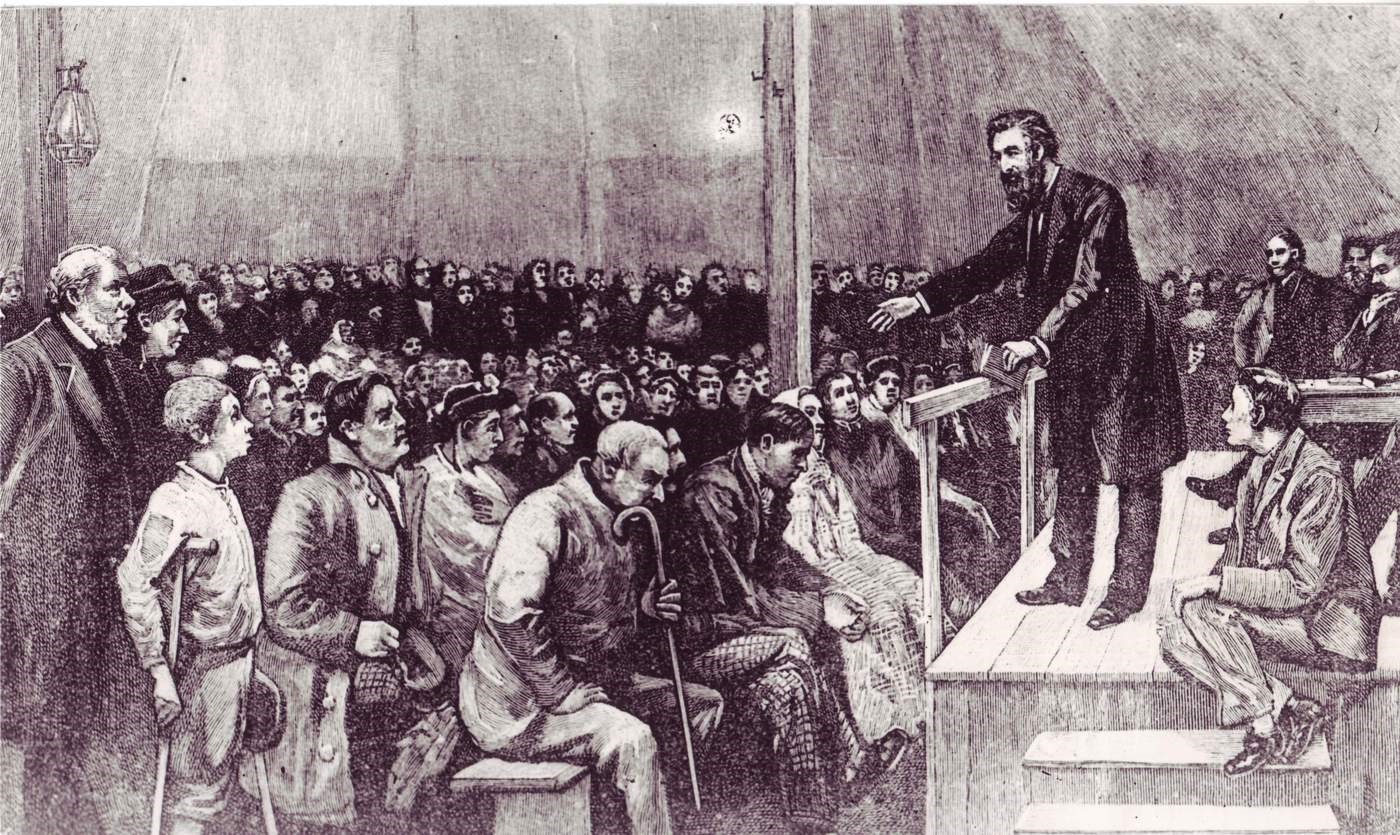
William Booth preaches at a meeting in a tent in East London (photo: International Heritage Centre)
Over the next few years, the movement flourished. Its focus on teaching people about the message of Jesus in a way they could relate to, meeting wherever they could – dance halls, bowling alleys and outdoors – as well as addressing some of their material needs, saw many people become Christians. Despite opposition from parts of the public who disliked some of the Booths’ methods and style, many joined.
Their focus on those who had been rejected by the traditional churches was key. All were welcome – including those impoverished and disadvantaged.
A renaming
 It was in 1878 that The Christian Mission got its present name. William Booth objected to a phrase contained in that year’s annual report: ‘The Christian Mission … is a Volunteer Army.’ By replacing the word ‘volunteer’, The Salvation Army had its new title and with it an inspired metaphor for its role in fighting the injustices of society and in bringing people to understand God. Over time, the organisation gained military-style titles (ministers are ‘officers’, for example) and even uniforms designed to publicly demonstrate a commitment to God.
It was in 1878 that The Christian Mission got its present name. William Booth objected to a phrase contained in that year’s annual report: ‘The Christian Mission … is a Volunteer Army.’ By replacing the word ‘volunteer’, The Salvation Army had its new title and with it an inspired metaphor for its role in fighting the injustices of society and in bringing people to understand God. Over time, the organisation gained military-style titles (ministers are ‘officers’, for example) and even uniforms designed to publicly demonstrate a commitment to God.
Despite the differences between the Army of today and that of 1865, the organisation continues to be relevant to people and their situations. From weekly worship services, outdoor events, clubs and activities through to responding to disasters and providing practical support to those in need of help, the same spirit of putting the gospel into action as in those early days carries on.
Today, statues of William and Catherine Booth stand in the area of London where The Salvation Army began
In Canada and Bermuda
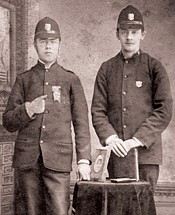 The Salvation Army began its work in Canada in 1882, just fifteen years after Confederation, and quickly began giving hope to those in need in this country.
The Salvation Army began its work in Canada in 1882, just fifteen years after Confederation, and quickly began giving hope to those in need in this country.
The first open-air ‘meetings’, or worship services, were held in Toronto in January 1882, and in London, Ontario, five months later. These were led by British immigrants who had known the Army in their homeland. Official Salvation Army operations began in July of that year when Major Thomas Moore arrived from the U.S. headquarters to take charge. By then there were 11 ‘corps’ or church congregations in Ontario, and a year later Canada was declared an independent ‘territory’, responsible for its own governance within the worldwide organization.
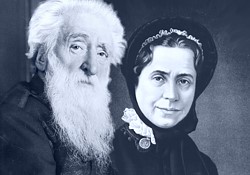 William and Catherine Booth, founders of The Salvation Army
William and Catherine Booth, founders of The Salvation Army
From the beginning, the Army in Canada adopted founder William Booth’s philosophy that there is little point preaching ‘salvation’ to hungry people. And so, the concept of ‘soup, soap and salvation’ took hold, later to be developed into the comprehensive social service programs The Salvation Army operates today, many of them in partnership with government.
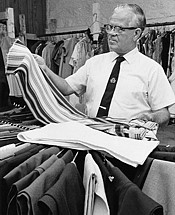 When the Army came to Canada, there was much opposition to its methods from civic politicians and other entrenched interests in the early days, and Salvationists were often beaten and jailed for their activities in the streets of Canada’s cities and towns. Despite this, there was eventual acceptance of the movement as it demonstrated the social benefits that accrued from its activities. The men’s social work began in 1890 with a Prison Gate Home in Toronto. The same year a children’s shelter was opened. The first maternity home was opened in Saint John, NB, in 1898, precursor to The Salvation Army Grace Hospitals. In 1901 The Salvation Army recommended to the federal government that a prisoner probation system be adopted, leading to Canada’s first parole program. In 1908 salvage work (now called ‘recycling’) began in Toronto, leading to the well-known Thrift Stores. In 1911 the first juvenile detention centre was established in Manitoba and turned over to the Army to operate. That same year a farm colony was established in Coombs, BC.
When the Army came to Canada, there was much opposition to its methods from civic politicians and other entrenched interests in the early days, and Salvationists were often beaten and jailed for their activities in the streets of Canada’s cities and towns. Despite this, there was eventual acceptance of the movement as it demonstrated the social benefits that accrued from its activities. The men’s social work began in 1890 with a Prison Gate Home in Toronto. The same year a children’s shelter was opened. The first maternity home was opened in Saint John, NB, in 1898, precursor to The Salvation Army Grace Hospitals. In 1901 The Salvation Army recommended to the federal government that a prisoner probation system be adopted, leading to Canada’s first parole program. In 1908 salvage work (now called ‘recycling’) began in Toronto, leading to the well-known Thrift Stores. In 1911 the first juvenile detention centre was established in Manitoba and turned over to the Army to operate. That same year a farm colony was established in Coombs, BC.
The Salvation Army’s status in Canada was entrenched in law in 1909 when parliament passed an Act giving the organization legal standing, its governance to be conducted by The Governing Council of The Salvation Army in Canada, a structure that continues to this day. The Canadian Territory was initially led by British and American officers, but by 1903 a consolidated Training College was opened in Toronto, allowing Canadian Salvationists to take more leadership responsibility.
Empress of Ireland
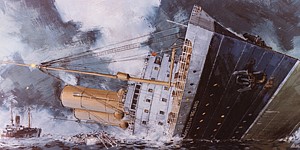 In 1914 the Army shared in the national tragedy of the sinking of The Empress of Ireland in the St. Lawrence. On board were 167 Salvationists, bound for an international congress in London. Most of them, including the national commander and members of the Canadian Staff Band, were drowned. The Staff Band was not re-formed until 1969.
In 1914 the Army shared in the national tragedy of the sinking of The Empress of Ireland in the St. Lawrence. On board were 167 Salvationists, bound for an international congress in London. Most of them, including the national commander and members of the Canadian Staff Band, were drowned. The Staff Band was not re-formed until 1969.
Canada’s involvement in the Great War of 1914-1918 saw the appointment of the first Salvation officer as a chaplain in the Canadian armed forces, and the donation of five motor ambulances to forces serving overseas. At the end of the war, military hostels were opened in Kingston, London, Toronto, Winnipeg and other cities, for returning soldiers.me for seniors
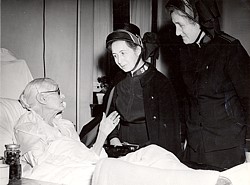 Innovation in social services continued even as the organization matured: the first seniors’ residence, or Eventide Home, was opened in Edmonton in 1926, and Grace Hospitals were opened in major cities across the country.
Innovation in social services continued even as the organization matured: the first seniors’ residence, or Eventide Home, was opened in Edmonton in 1926, and Grace Hospitals were opened in major cities across the country.
World War Service
The onset of World War II found the Army accompanying Canada’s armed forces overseas not only as chaplains but as the operators of Maple Leaf Clubs, providing rest and relaxation for the troops.
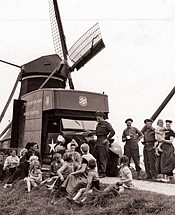 By the end of the war, there were clubs in Britain, France, Germany, Belgium, Holland and India. They were mostly staffed by Salvation Army Auxiliaries, some of them as young as twenty years old. They provided a taste of home, with Canadian cooking, mail forwarding and social activities, including dances and short-term accommodation. On the home front at the end of the war, Salvationists at Canadian ports welcomed the ‘war brides’ of Canadian servicemen.
By the end of the war, there were clubs in Britain, France, Germany, Belgium, Holland and India. They were mostly staffed by Salvation Army Auxiliaries, some of them as young as twenty years old. They provided a taste of home, with Canadian cooking, mail forwarding and social activities, including dances and short-term accommodation. On the home front at the end of the war, Salvationists at Canadian ports welcomed the ‘war brides’ of Canadian servicemen.
In the post-war years, further social service innovations included an anti-suicide bureau and victim witness assistance programs, the latter eventually being absorbed by the criminal justice system.
The Salvation Army’s quasi-military structure allows the ability to quickly respond to urgent needs – the Halifax explosion, Winnipeg flood, Quebec ice storm and 9/11 to name a few. As the ethnic and cultural makeup of the country changed, so did the demographics of the Army. Salvationists now formally worship in 11 languages and provide services in many others.
The Salvation Army Theology and Practice
The theology of the Salvation Army is derived from that of Methodism, although it is distinctive in institution and practice. A peculiarity of the Army is that it gives its clergy titles of military ranks, such as "lieutenant" or "major". It does not celebrate the rites of Baptism and Holy Communion. However, the Army's doctrine is otherwise typical of holiness churches in the Wesleyan–Arminian tradition. The Army's purposes are "the advancement of the Christian religion ... of education, the relief of poverty, and other charitable objects beneficial to society or the community of mankind as a whole"




